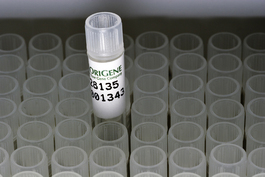GSTM5 (NM_000851) Human Untagged Clone
CAT#: SC310618
GSTM5 (untagged)-Human glutathione S-transferase mu 5 (GSTM5)
"NM_000851" in other vectors (4)
Product Images

Specifications
| Product Data | |
| Type | Human Untagged Clone |
| Tag | Tag Free |
| Symbol | GSTM5 |
| Synonyms | GSTM5-5; GTM5 |
| Vector | pCMV6-Entry |
| E. coli Selection | Kanamycin (25 ug/mL) |
| Mammalian Cell Selection | Neomycin |
| Sequence Data |
>NCBI ORF sequence for NM_000851, the custom clone sequence may differ by one or more nucleotides
ATGCCCATGACTCTGGGGTACTGGGACATCCGTGGGCTGGCCCACGCCATCCGCTTGCTCCTGGAATACA CAGACTCAAGCTATGTGGAAAAGAAGTACACGCTGGGGGACGCTCCTGACTATGACAGAAGCCAGTGGCT GAATGAAAAATTCAAGCTGGGCCTGGACTTTCCCAATCTGCCCTACTTGATTGATGGGGCTCACAAGATC ACCCAGAGCAATGCCATCCTGCGCTACATTGCCCGCAAGCACAACCTGTGTGGGGAGACAGAAGAGGAGA AGATTCGTGTGGACATTTTGGAGAACCAGGTTATGGATAACCACATGGAGCTGGTCAGACTGTGCTATGA CCCAGATTTTGAGAAACTGAAGCCAAAATACTTGGAGGAACTCCCTGAAAAGCTAAAGCTCTACTCAGAG TTTCTGGGGAAGCGGCCATGGTTTGCAGGAGACAAGATCACCTTTGTGGATTTCCTTGCCTATGATGTCC TTGACATGAAGCGTATATTTGAGCCCAAGTGCTTGGACGCCTTCCTAAACTTGAAGGACTTCATCTCCCG CTTTGAGGGTTTGAAGAAGATCTCTGCCTACATGAAGTCCAGCCAATTCCTCCGAGGTCTTTTGTTTGGA AAGTCAGCTACATGGAACAGCAAATAG |
| Restriction Sites | SgfI-MluI |
| ACCN | NM_000851 |
| OTI Disclaimer | Due to the inherent nature of this plasmid, standard methods to replicate additional amounts of DNA in E. coli are highly likely to result in mutations and/or rearrangements. Therefore, OriGene does not guarantee the capability to replicate this plasmid DNA. Additional amounts of DNA can be purchased from OriGene with batch-specific, full-sequence verification at a reduced cost. Please contact our customer care team at custsupport@origene.com or by calling 301.340.3188 option 3 for pricing and delivery. The molecular sequence of this clone aligns with the gene accession number as a point of reference only. However, individual transcript sequences of the same gene can differ through naturally occurring variations (e.g. polymorphisms), each with its own valid existence. This clone is substantially in agreement with the reference, but a complete review of all prevailing variants is recommended prior to use. More info |
| OTI Annotation | This TrueClone is provided through our Custom Cloning Process that includes sub-cloning into OriGene's pCMV6 vector and full sequencing to provide a non-variant match to the expected reference without frameshifts, and is delivered as lyophilized plasmid DNA. |
| Product Components | The cDNA clone is shipped in a 2-D bar-coded Matrix tube as dried plasmid DNA. The package also includes 100 pmols of both the corresponding 5' and 3' vector primers in separate vials. Every lot of primer is tested to provide clean sequencing of OriGene TrueClones. |
| Reconstitution | 1. Centrifuge at 5,000xg for 5min. 2. Carefully open the tube and add 100ul of sterile water to dissolve the DNA. 3. Close the tube and incubate for 10 minutes at room temperature. 4. Briefly vortex the tube and then do a quick spin (less than 5000xg) to concentrate the liquid at the bottom. 5. Store the suspended plasmid at -20°C. The DNA is stable for at least one year from date of shipping when stored at -20°C. |
| Reference Data | |
| RefSeq | NM_000851.3, NP_000842.2 |
| RefSeq Size | 1583 bp |
| RefSeq ORF | 657 bp |
| Locus ID | 2949 |
| Cytogenetics | 1p13.3 |
| Domains | GST_N, GST_C |
| Protein Pathways | Drug metabolism - cytochrome P450, Glutathione metabolism, Metabolism of xenobiotics by cytochrome P450 |
| Gene Summary | 'Cytosolic and membrane-bound forms of glutathione S-transferase are encoded by two distinct supergene families. At present, eight distinct classes of the soluble cytoplasmic mammalian glutathione S-transferases have been identified: alpha, kappa, mu, omega, pi, sigma, theta and zeta. This gene encodes a glutathione S-transferase that belongs to the mu class. The mu class of enzymes functions in the detoxification of electrophilic compounds, including carcinogens, therapeutic drugs, environmental toxins and products of oxidative stress, by conjugation with glutathione. The genes encoding the mu class of enzymes are organized in a gene cluster on chromosome 1p13.3 and are known to be highly polymorphic. These genetic variations can change an individual's susceptibility to carcinogens and toxins as well as affect the toxicity and efficacy of certain drugs. Diversification of these genes has occurred in regions encoding substrate-binding domains, as well as in tissue expression patterns, to accommodate an increasing number of foreign compounds. [provided by RefSeq, Jul 2008]' |
Documents
| Product Manuals |
| FAQs |
Resources
Other Versions
| SKU | Description | Size | Price |
|---|---|---|---|
| RC208900 | GSTM5 (Myc-DDK-tagged)-Human glutathione S-transferase mu 5 (GSTM5) |
USD 98.00 |
|
| RG208900 | GSTM5 (GFP-tagged) - Human glutathione S-transferase mu 5 (GSTM5) |
USD 460.00 |
|
| RC208900L3 | Lenti ORF clone of Human glutathione S-transferase mu 5 (GSTM5), Myc-DDK-tagged |
USD 620.00 |
|
| RC208900L4 | Lenti ORF clone of Human glutathione S-transferase mu 5 (GSTM5), mGFP tagged |
USD 620.00 |
{0} Product Review(s)
Be the first one to submit a review






























































































































































































































































 Germany
Germany
 Japan
Japan
 United Kingdom
United Kingdom
 China
China
